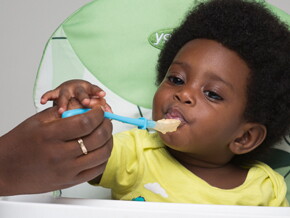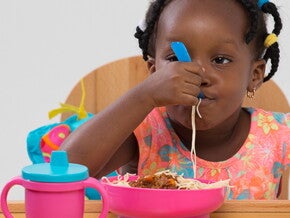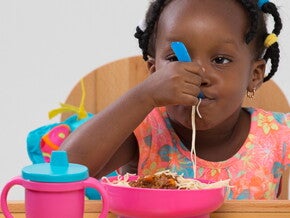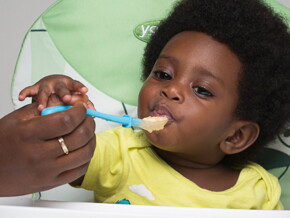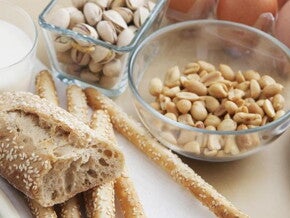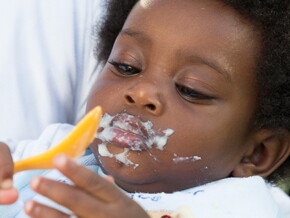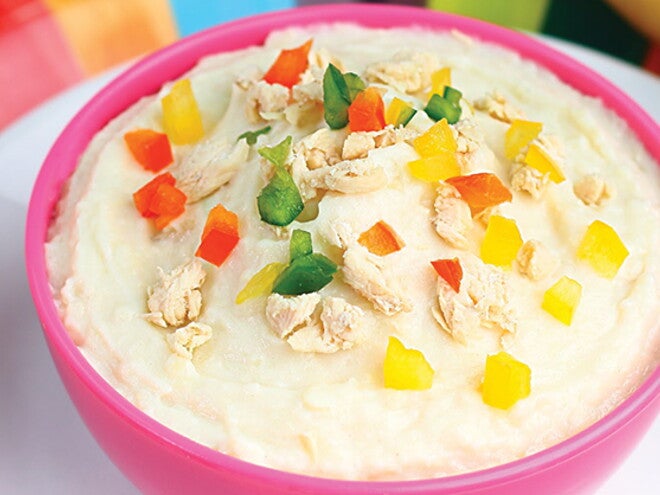
As you probably already know, Toddlers are incredibly active and energetic! For their body size, Toddlers need to make every bite count with nutritious meals and snacks.
In order for Toddlers to get the nutrients they need for growth and development, meals should provide essential nutrients in a small portion and be served frequently during the day—typically three balanced meals and two or three nutritious in-betweens during the day.
Your 12-month-old needs foods from each food group every day. Below are suggested servings for each food group.
Food Groups | Daily Intake* | Serving Size Examples |
|---|---|---|
| Dairy | 470 ml | 120 – 240 ml |
Grains and cereals | 28g grain Equivalents (At least ½ of grain servings should be whole grains) | Each of the following contributes about 14g equivalent grain: ½ slice whole grain bread ¼ whole wheat bagel 1 pancake ¼ cup cooked pasta ¼ cup infant cereal Each of the following contributes about ¼ oz. serving: 2 animal crackers ¼ cup toasted oat cereal |
| Vegetables | 170ml | 60ml cup vegetable puree, or mashed vegetables, or soft cooked, chopped peeled vegetables |
| Fruits | 170 ml | 60ml cup fruit puree or mashed fruit or soft, chopped, peeled, fruit |
| Meat/Beans | 43 g | 3 tblsp. plain, easy to chew, thoroughly cooked meat or poultry OR About 1 scrambled egg |
* Your Toddler's needs may be greater or less than these stated; always follow your child's hunger and fullness cues
Laying a healthy foundation
These tips can help you teach your Toddler good eating habits that will stick with her for a lifetime:
1. Choose foods wisely. During your Toddler’s transition from breastmilk or formula to solids, nutrition gaps become more common. The 2008 Nestlé-sponsored Feeding Infants and Toddlers Study (FITS) found that on a given day, Toddlers aren’t eating enough fruits and veggies, and are not meeting the recommended amount of
Potassium and fibre. Also, more than half of Toddlers are not getting enough Vitamin E from the foods they eat.
That’s why it’s important to offer your Toddler a variety of fruits, veggies, whole grains, lean meats and dairy. Also include vegetable fats with Omega-3 fat, like canola or soybean oil.
2. Mix it up. A balanced diet depends on a variety of foods from every food group every day—whole grains, fruit, vegetables, meat and beans and dairy. Also be sure to include foods with nutrients that your child may be lacking: Iron, Zinc, Potassium, Vitamin E, and fibre.
3. Serve a rainbow of fruits and veggies. A variety of colourful foods expands your child’s tastes and provides a variety of nutrients for her tummy. Introducing new foods with old favourites may improve acceptance. For example, if she likes corn, try adding small red pepper dices.
4. Let your child decide how much to eat. Teach your child to respect her appetite by letting her decide what and how much to eat. If she’s hungry, let her eat heartily. But if she’s full, let her stop.
5. Snack smart. Serve three small meals and two to three snacks a day. Because some Toddlers get 25% of their calories from snacks, make sure to offer nutritious choices for every snack. Avoid high-calorie, low-nutrient foods, like chips, cookies and sugary drinks.
6. Drink responsibly. Beverages are important for hydration, but too many of them can make your Toddler too full to eat. Your Toddler’s beverage choices should include milk, 100% juice or water. Limit milk to 2 cups per day. If serving 100% fruit juice offer only in a cup, not a bottle, and limit the amount to 120 ml per day; the rest of their fluids should be from water.
7. Offer healthy fats. Young children need calories from fat for growth and brain development. Incorporate healthy sources of predominantly unsaturated fat – fatty fish, avocados, food made with vegetable oils – into your toddlers diet.
8. Choose foods lower in sodium. Even if you think your child’s food tastes too bland, remember that she doesn’t need all the salt that tastes right to you. Sodium also becomes a preferred taste once it’s introduced.
Filling a Toddler’s nutrition gaps
To better understand Toddlers’ eating habits and nutrient intake, Nestlé sponsored the Feeding Infants and Toddlers Study (FITS) 2008. By knowing what Toddlers are really eating, we can better guide their food choices.
These are some common nutrition gaps we found.
Fruits and vegetables contain essential vitamins, minerals and fibre. A diet high in fruits and veggies is important for healthy growth and development.
Nestlé FITS 2008 found that on a given day, 25% of Toddlers 12 to 24 months don’t eat a single distinct portion of fruit and 30% don’t eat a single distinct portion of vegetables.
How to get it: Offer your Toddler 225g fruit and 275g of vegetables every day. Fruit and vegetable servings can be from fresh, frozen or pureed canned foods, but need to be cut up into small, easy-to-eat pieces. Remember you can still serve purees in Toddler-favourite foods to add variety.
Cereals. According to Nestlé FITS 2008, about 60% of Toddlers between ages 12 and 18 months are eating adult, nonwhole grain cereals during the day. But transitioning to adult cereals may not be best for your Toddler. These cereals may not be as rich in Iron as infant cereal and may be high in sugar.
How to get it: Continue to give your Toddler Iron-rich infant cereal, and remember she can be offered cereal at any time of day!
Sweetened beverages and desserts. There’s not a lot of room in your Toddler’s diet for foods that provide calories but not many nutrients. Nestlé FITS 2008 found that more than 70% of Toddlers consumed any type of sweet, dessert and sweetened beverage on a given day. Desserts, sweets and sweetened beverages can be high in calories compared to the micronutrients they provide, and can displace other nutritious foods in the diet.
How to get it: In place of sweets, serve your Toddler more nutritious options such as fruits, yogurt and cereals and snacks that are made with whole grains.
Fibre plays a big role in your child’s digestive health. However, Nestlé FITS 2008 found that on a given day, virtually no Toddlers are meeting the recommended daily intake of 19 grams of fibre.
How to get it: Every day offer whole grains, and fresh, frozen, pureed or canned fruits and vegetables that are the right size and texture for your child.
Vitamin E is an important antioxidant that helps protect the cells in the body from damage. According to Nestlé FITS 2008, about half of year-old Toddlers are not getting the recommended amount of Vitamin E from the foods they eat.
How to get it: Foods that have Vitamin E include vegetable oils (canola, corn, soybean), avocados, whole grains and some leafy green vegetables (spinach, broccoli).
Potassium is a mineral that helps muscles work properly. According to Nestlé FITS 2008, virtually no Toddlers are meeting the recommended intake of Potassium in their diet.
How to get it: Potassium is found in many foods, including potatoes, sweet potatoes, avocado, spinach, yogurt, bananas and citrus fruits.
Healthy fats aid in growth and brain development. Fat also helps the body use vitamins, such as Vitamins A, D, E and K. Nestlé FITS 2008 found that about 23% of Toddlers don’t eat the recommended amount of total fat. A Toddler’s diet should include about 30 to 40% of total calories from fat, preferably mono- and polyunsaturated fats like those found in fish, avocados, and foods made with vegetable oils, such as canola and soybean oil. These healthy fats should replace the saturated fats found in high-fat dairy products such as butter, cheese and fatty meats such as hot dogs, bacon and sausages.
How to get it: Try preparing foods with fat, like soy or canola oil, that also have the Omega-3 fat, alpha-linolenic acid, or offer condiments such as mayonnaise or salad dressings made with these oils. Remember to limit foods high in saturated and trans fats.
